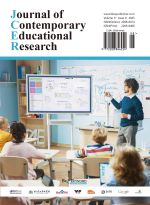Children’s Language Learning from an Embodied Cognition Perspective: Opportunities, Challenges, and Future Directions
Abstract
The emergence of embodied cognition theory has altered our traditional understanding of children’s language learning, emphasizing the close connection between the body, environment, and movement. This paper discusses the opportunities, challenges, and future directions of research on children’s language learning from the perspective of embodied cognition. It concludes that multisensory engagement can greatly improve children’s comprehension and memorization of language knowledge and that language acquisition is intimately tied to bodily perception, movement, and emotional experience. In addition, children’s language acquisition can also be effectively aided by embodied cognition techniques as multimedia aids, gesture and enactment, and imagery. Based on previous evidence, we propose an integrated language learning framework and a new relevance-integration taxonomy for children’s language learning from the perspectives of embodied cognition and cognitive load theories. In order to support the long-term growth of children’s language education, future research should focus more on the requirement of embodied language learning in the preschool-primary transition and optimize the teaching objectives and contents.
References
Barsalou LW, 2008, Grounded Cognition. Annual Review of Psychology, 59: 617–645. https://doi.org/10.1146/annurev.psych.59.103006.093639
Lakoff G, Johnson M, 1980, Metaphors We Live By, University of Chicago Press, Chicago.
Glenberg AM, Gutierrez T, Levin JR, et al., 2004, Activity and Imagined Activity Can Enhance Young Children’s Reading Comprehension. Journal of Educational Psychology, 96(3): 424–436. https://doi.org/10.1037/0022-0663.96.3.424
Paivio A, 1986, Mental Representations: A Dual Coding Approach, Oxford University Press, Oxford.
Lakoff G, Johnson M, 1999, Philosophy in the Flesh: The Embodied Mind and Its Challenge to Western Thought, Basic Books.
Mayer KM, Yildiz IB, Macedonia M, et al., 2015, Visual and Motor Cortices Differentially Support the Translation of Foreign Language Words. Current Biology, 25(4): 530–535. https://doi.org/10.1016/j.cub.2014.11.068
Mayer RE, 2009, Multimedia Learning (2nd ed.). Cambridge University Press.
Glenberg AM, Gallese V, 2012, Action-Based Language: A Theory of Language Acquisition, Comprehension, and Production. Cortex, 48(7): 905–922. https://doi.org/10.1016/j.cortex.2011.04.010
Hald LA, de Nooijer J, van Gog T, et al., 2016, Optimizing Word Learning Via Links to Perceptual and Motoric Experience. Educational Psychology Review, 28(3): 495–522. https://doi.org/10.1007/s10648-015-9334-2
de Koning BB, Bos LT, Wassenburg SI, et al., 2017, Effects of a Reading Strategy Training Aimed at Improving Mental Simulation in Primary School Children. Educational Psychology Review, 29(4): 869–886.
Lesgold AM, DeGood H, Levin JR, 1977, Pictures and Young Children’s Prose Learning: A Supplementary Report. Journal of Reading Behavior, 9(4): 353–360.
Cohen MT, Johnson HL, 2012, Improving the Acquisition and Retention of Science Material by Fifth-Grade Students Through the Use of Imagery Interventions. Instr Sci, 40: 925–955. https://doi.org/10.1007/s11251-011-9197-y
Tellier M, 2008, The Effect of Gestures on Second Language Memorisation by Young Children. Gesture, 8(2): 219–235. https://doi.org/10.1075/gest.8.2.06tel
Porter A, 2016, A Helping Hand with Language Learning: Teaching French Vocabulary with Gesture. The Language Learning Journal, 44(2): 236–256. https://doi.org/10.1080/09571736.2012.750681
Glenberg AM, Goldberg AB, Zhu X, 2011, Improving Early Reading Comprehension Using Embodied CAI. Instructional Science, 39(1): 27–39. https://doi.org/10.1007/s11251-009-9096-7
McNeill D, 1992, Hand and Mind: What Gestures Reveal About Thought, University of Chicago Press, Chicago.
Silverman R, 2013, Investigating Video as a Means to Promote Vocabulary for At-Risk Children. Contemporary Educational Psychology, 38(2): 170–179. https://doi.org/10.1016/j.cedpsych.2013.03.001
de Koning BB, Zhang S, Sepp S, 2025, Integrating Human Movement in Learning: Advancements in Language Instruction, Multimedia, and Theory. Educational Psychology Review, 37: 51. https://doi.org/10.1007/s10648-025-10027-1
Zou L, Zhang Z, Mavilidi M, et al., 2025, The Synergy of Embodied Cognition and Cognitive Load Theory for Optimized Learning. Nature Human Behaviour, 9: 877–885. https://doi.org/10.1038/s41562-025-02152-2
Risko EF, Gilbert SJ, 2016, Cognitive Offloading. Trends in Cognitive Sciences, 20(9): 676–688. https://doi.org/10.1016/j.tics.2016.07.002
Block CC, Parris SR, Whiteley CS, 2008, CPMs: A Kinesthetic Comprehension Strategy. The Reading Teacher, 61(6): 460–470. https://doi.org/10.1598/RT.61.6.3
Xu H, Chen W, Gao Q, 2018, Embodied Cognitive Strategy’s Influence on Preschool Children’s Reading Comprehension: Examination on Index Hypothesis. Studies in Early Childhood Education, 5: 28–38.
Rubman CN, Waters HS, 2001, A, B Seeing: The Role of Constructive Processes in Children’s Comprehension Monitoring. Journal of Educational Psychology, 93(2): 213–226. https://doi.org/10.1037/0022-0663.92.3.503
Post LS, van Gog T, Paas F, et al., 2013, Effects of Simultaneously Observing and Making Gestures While Studying Grammar Animations on Cognitive Load and Learning. Computers in Human Behavior, 29(4): 1450–1455. https://doi.org/10.1016/j.chb.2013.01.005
Walker E, Adams A, Restrepo MA, et al., 2017, When (and How) Interacting with Technology-Enhanced Storybooks Helps Dual Language Learners. Translational Issues in Psychological Science, 3(1): 66–79. https://doi.org/10.1037/tps0000100
Abrahamson D, Lindgren R, 2014, Embodiment and Embodied Design, in RK Sawyer (Ed.), The Cambridge Handbook of the Learning Sciences (2nd ed.), Cambridge University Press, Cambridge, 358–376. https://doi.org/10.1017/CBO9781139519526.022
Ye H, 2015, The Body and Learning: Embodied Cognition and Its Impact on Traditional View of Education. Educational Research, 36(4): 108–120.
Rowe ML, Silverman RD, Mullane BE, 2013, The Role of Pictures and Gestures as Nonverbal Aids in Preschoolers’ Word Learning in a Novel Language. Contemporary Educational Psychology, 38(2): 109–117.

